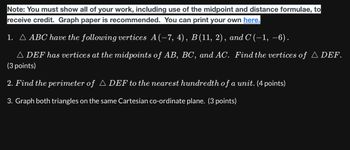
Elementary Geometry For College Students, 7e
7th Edition
ISBN: 9781337614085
Author: Alexander, Daniel C.; Koeberlein, Geralyn M.
Publisher: Cengage,
expand_more
expand_more
format_list_bulleted
Question

Transcribed Image Text:Note: You must show all of your work, including use of the midpoint and distance formulae, to
receive credit. Graph paper is recommended. You can print your own here.
1. A ABC have the following vertices A(-7, 4), B(11, 2), and C (-1, −6).
▲ DEF has vertices at the midpoints of AB, BC, and AC. Find the vertices of ▲ DEF.
(3 points)
2. Find the perimeter of ▲ DEF to the nearest hundredth of a unit. (4 points)
3. Graph both triangles on the same Cartesian co-ordinate plane. (3 points)
SAVE
AI-Generated Solution
info
AI-generated content may present inaccurate or offensive content that does not represent bartleby’s views.
Unlock instant AI solutions
Tap the button
to generate a solution
to generate a solution
Click the button to generate
a solution
a solution
Knowledge Booster
Similar questions
- I need help with those questions; thank you. 1, A simple digraph with 4 vertices with in-degrees 0, 1, 2, 2 and out-degrees 0, 1, 1, 3. Is it possible or impossible? Show an example or explain why it’s impossible 2, A simple digraph with 5 vertices with in-degrees 0, 1, 2, 4, 5 and out-degrees 0, 3, 3, 3, 3. Is it possible or impossible? Show an example or explain why it’s impossible.arrow_forwardIdentify the vertices and foci of each. Then sketch the graph.arrow_forwardplease write clearly and prove all the steps. thank you.arrow_forward
arrow_back_ios
arrow_forward_ios
Recommended textbooks for you
 Elementary Geometry For College Students, 7eGeometryISBN:9781337614085Author:Alexander, Daniel C.; Koeberlein, Geralyn M.Publisher:Cengage,
Elementary Geometry For College Students, 7eGeometryISBN:9781337614085Author:Alexander, Daniel C.; Koeberlein, Geralyn M.Publisher:Cengage, Elementary Geometry for College StudentsGeometryISBN:9781285195698Author:Daniel C. Alexander, Geralyn M. KoeberleinPublisher:Cengage Learning
Elementary Geometry for College StudentsGeometryISBN:9781285195698Author:Daniel C. Alexander, Geralyn M. KoeberleinPublisher:Cengage Learning

Elementary Geometry For College Students, 7e
Geometry
ISBN:9781337614085
Author:Alexander, Daniel C.; Koeberlein, Geralyn M.
Publisher:Cengage,

Elementary Geometry for College Students
Geometry
ISBN:9781285195698
Author:Daniel C. Alexander, Geralyn M. Koeberlein
Publisher:Cengage Learning